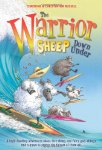There are lots of books coming out these days that are about life on Earth in the future. Most are pretty grim, and some are downright depressing. I sometimes find it hard to read such titles because they are so dark. Today's fiction title is different from many of these futuristic books. Yes, we humans have mucked up the world, and yes the characters are struggling to survive. The difference is that in this story there is a message of hope. The main character is able to make a difference, and we are left with a sense that all is not lost. Not yet anyway.
 Jenn Reese
Jenn Reese
Fiction
For ages 9 to 12
Candlewick, 2012, 978-0763654177
Many years ago, humans finally came to understand that their population was too large and no longer sustainable. They came up with an extraordinary solution to this problem: they decided that some of their number they would modify their bodies to that they could live in places that had hitherto not been populated by humans. Thus the Kampaii lived in the shallower oceans, the Deepfell lived in the deep oceans, the Aviars had wings and lived in the skies, and the Equian people had hooves and lived in the deserts.
Life has been comfortable for the Coral Kampii, Aluna’s people, until now. Recently several of the Kampii have drowned because their shell necklaces, the tech devices that allow them to breathe underwater, have failed. When Aluna finds the body of her friend Makina floating in a kelp forest she gets furious. How can the Elders pretend that all is well? Someone needs to find out why the breathing necklaces are failing before all the Coral Kampii die.
On the day when Aluna is supposed to get her tail, she decides that she cannot stand by while her people die. Someone has to go to the Above World to find out why the necklaces, which were made by HydroTek, are failing. With her best friend Hoku by her side, Aluna leaves the only world she knows to walk around on her feet, and to face the Upgraders, creatures whose bodies are made of machine parts and “parts” that were taken from other beings.
Aluna and Hoku are not in the Above World long before they are captured by Aviars and taken to Skyfeather’s Landing, one of the Aviar strongholds. At first the Kampii teenagers are prisoners, but when they help defend the city from the Upgraders, Aluna and Hoku and the people of the air become allies. The Aviar have managed to free themselves from the stranglehold of Fathom, the Upgrader leader, and Aluna understands that her people will have to do the same. As long as Fathom is in control of the Hydrotek technology, her people will never be able to control their breathing necklaces and the other tech they depend on.
With the blessing of the Aviars, Hoku and Aluna set off once more to try to find HydroTek and they meet Dash, an Equian teen. Since Dash is on his own, he joins Hoku and Aluna in their quest, standing by their sides when they are pursued by Upgraders. The three young people are then joined by Calli, an Avian that they made friends with when they were in Skyfeather’s Landing. Though they are all very different in temperament and personality, when they are together, the four teens are a force to be reckoned with. Aluna and Dash are excellent fighters, while Calli and Hoku are tech wizards. They do not know if they will be strong enough to defeat Fathom and the creatures he has made, but they have to try.
This fascinating and beautifully written book will delight readers who have a fondness for books that are full of bizarre and otherworldly beings and creatures. Elements of fantasy and science fiction are combined with tense adventure sequences to give readers a memorable futuristic title. Readers will be interested to see how young people can change their world if they have the will and courage to defend what they know is right.
This is the first title in what promises to be an exciting new series.

















